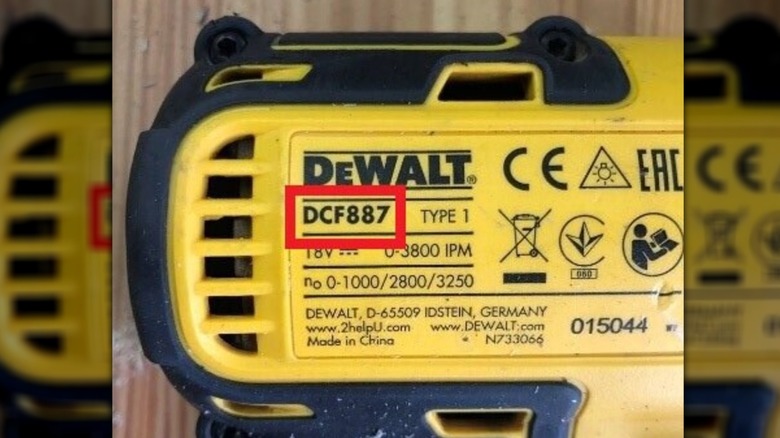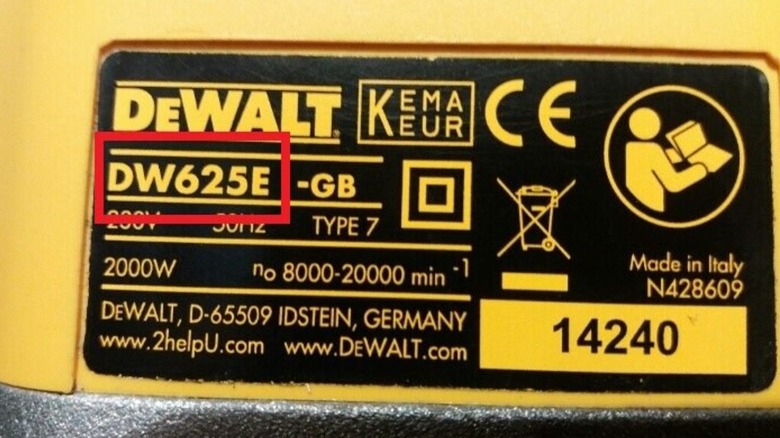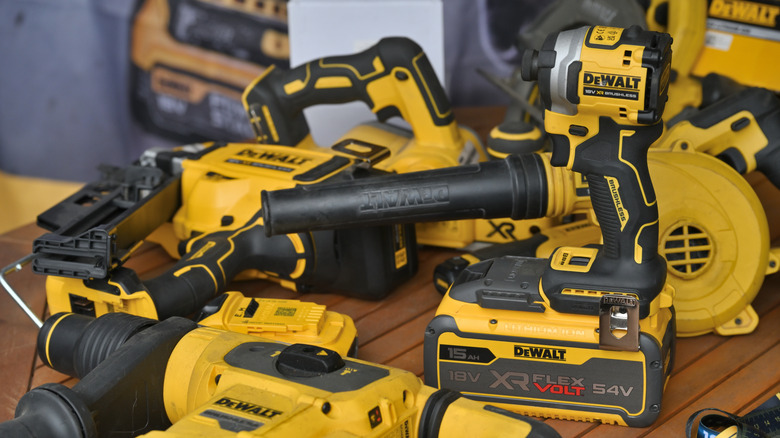Where To Find Your DeWalt Model Number (And How To Decode It)
Whether it's tools for your garden or for cleaning your home, there's probably something in the DeWalt portfolio with your name on it. Apart from having a slew of tools made in the USA, it also offers options from a wide variety of budgets that everyone from homeowners to professionals can appreciate. However, if you're one of those people who are a little too trigger-happy with their garage shopping, chances are you have a ton of DeWalt tools that need registration. To do this, you'll need to find the model number assigned to it.
If you're fresh out of the store with your new DeWalt item, you'll have the option to easily see the model number on either the official receipt or on the packaging itself. But if you no longer have both of these items on hand and need access to your DeWalt model number immediately, there is another way you can find it directly on the tool itself. DeWalt has made it so you can easily spot the model number on the device's rating label. The rating label can usually be found printed on a black or yellow sticker, which you can find on the back or the bottom of the tool. Apart from the model number, you'll also be able to find other useful details on your rating label, like the certifications, voltage, and the country of manufacturing. In addition, DeWalt notes that the serial number and date code can be found on this label as well.
How to decode your DeWalt model number
These days, there are many non-DeWalt tools that work with their batteries, with some of them actively mimicking the appearance of the official DeWalt products, such as with the color palette. To check if the tool is authentic, DeWalt shares that all its model numbers should start with a "D". In addition, DeWalt claims its model numbers follow specific nomenclature, like the three letters + three numbers for cordless models and the "D" + letters or numbers for corded ones. But take note, the same tools may have different model numbers, especially if they are sold in tandem with battery units. For example, DeWalt's Impact Driver has a model number of DCF887N-XJ if you buy the tool on its own. However, the unit sold alongside 2 Ah batteries has the DCF887D2-GB model number. On the other hand, the units with 5 Ah batteries use the DCF887P2-GB model number.
Not to mention, it's good to know that DeWalt says that some of its retailers will have assigned codes for tools sold through them, which explains why codes of even original tools may not always appear in the official DeWalt registration. If this happens to you, the power tool manufacturer recommends simply choosing the most similar option instead, as it will still honor this transaction as long as the correct tool was selected. When buying kits, DeWalt also reminds users that tool registration will need to be done for each tool, excluding its battery system.
Why knowing your DeWalt Model Number matters
As mentioned earlier, knowing your model number is the most useful when dealing with warranty-related matters, such as registration, verification, or claims. Depending on the tool, DeWalt has different warranty coverage options, such as a limited and lifetime warranty. In addition, the periods may also vary, as some tools have three or seven-year periods for their limited warranty coverage. In the same vein, the model number can also give you a clue if the tool is part of an ongoing product recall. Unfortunately, DeWalt has had multiple product recalls in the past, including its battery packs, battery chargers, corded electric screwdrivers, and cordless drills. So, if you suspect you're entitled to replacements, it's a good starting point, but you can also message DeWalt support for more information.
Apart from this, there are other reasons why knowing your model number can be useful. For people buying second-hand tools, model numbers are also a good way to know if it's just one of those DeWalt products you shouldn't buy. Because DeWalt offers hundreds of tool options, it's not surprising that a few simply fall behind in terms of performance, like some cordless handheld vacuum models, self-propelled mowers, and chainsaws. And of course, it also works to help identify the product as legitimate, which can be useful if you're ever trying to sell it to a careful buyer, be reimbursed by your company for an official purchase, or even trying to claim damages for insurance-related purposes.


